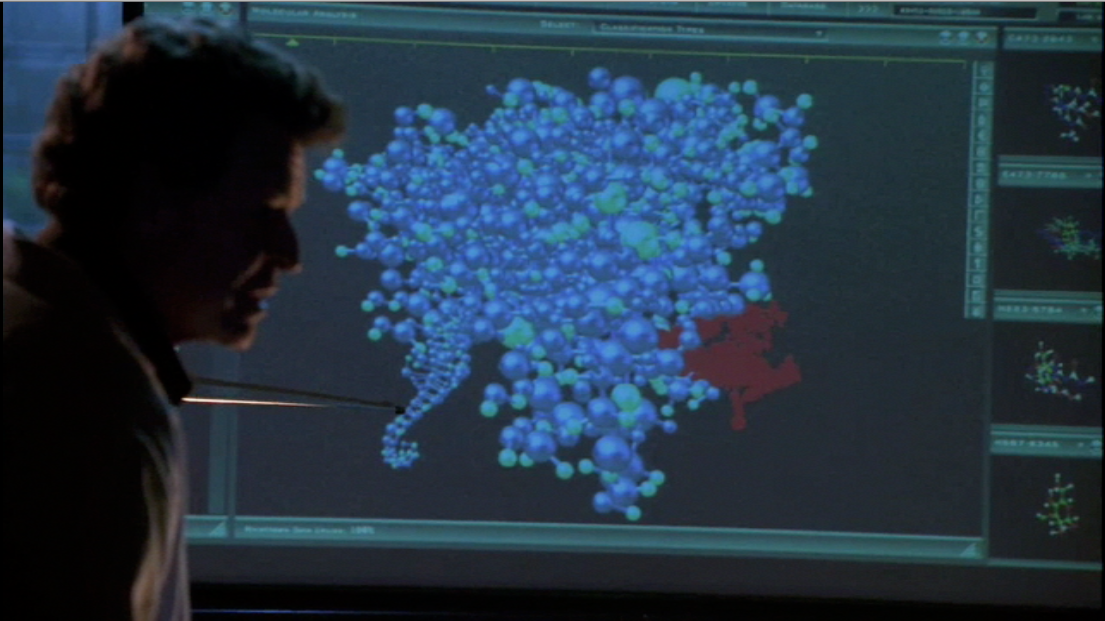The Show – FBI agent and crazy scientists solve crimes, commit crimes against science.
Like I keep saying. I'm actually a fan of the show, but every now and then the science gets too terrible for me to let stand.
The Scene – A deadly toxin is killing only certain genetic groups. It enters the air after being exposed to heat (either from a lit candle or hot tea). Just after the second attack, one of the show's scientists reveals a molecular model of the toxin. He shows that it has two parts: a deadly part that is just chromium trioxide and hydrogen cyanide, and an interchangeable targeting portion that recognizes the DNA sequence of the target genetic group. He also finds that the toxin has a seahorse on the end, an apparent signature.
 |
| This toxin will haunt my nightmares. But mostly just because of the terrible aesthetics. From Fringe. |
But I really wanted to discuss this scene because I don't think the public is clear on how scientists know the structures of the molecules they are studying. There are many ways to do this, and I hope I can talk about more of these methods later. For small molecules, various types of spectroscopy and mass spectrometry would work. For smaller proteins, nuclear magnetic resonance is an option, but what we're dealing with would have to be a pretty large protein. Electron microscopy will give some structural information but not the atomic-level resolution seen in the model. For that, we must use X-ray crystallography.
X-ray crystallography is a very important technique that was instrumental in the discovery of DNA's structure (see Rosalind Franklin), and is most often used today to look at the structure of various proteins. Basically, the proteins are crystallized, and the crystals are shot with a beam of X-rays. The atoms in the protein crystals cause the X-rays to diffract (or bend), and the diffraction pattern can be interpreted to determine a three-dimensional picture of the protein.
This is even more complicated than I made it sound. To make the crystals, you must begin with a large amount of very pure protein and test a large number of crystallization conditions. Even if you get crystals, there's no guarantee that they will diffract well. And even with good diffraction, it is not easy to interpret the pattern. Determining the structure of a protein from scratch can take years; entire PhD projects have centered around getting a single structure. It's ridiculous to think that the scientists in Fringe could get a crystal structure in a day.
Also, that structure looks terrible. It looks like whoever designed it saw a picture of a molecular structure, and interpreted it as just a random arrangement of orbs and sticks. A collection of orbs and sticks (representing the atoms and bonds of the proteins, respectively) is one of the ways to depict a molecule. But it's not a good choice for a wide view of a whole protein. There are better choices that show less atomic detail but more broad structural details.
 |
| Two different depictions of a real toxin. Which one would you show in your TV show? From PDB 1JKY. Made using PyMOL. |
 |
| The cutting edge or molecular art. Made from DNA! From Nature. |
 |
| Adding a toxin to someone's drink is a fine way to kill one person. Not a whole room full of people. Unless your victim is really good about sharing, I guess. From Fringe. |
While there's no way to get a real structure of the toxin in the time frame of an FBI investigation, there are other ways to get a good model. They could figure out the toxin's sequence of amino acid building blocks using mass spectrometry. Then, if their toxin is similar to existing toxins and DNA-binding proteins with known structures, the scientists could make a theoretical model of the toxin based on already existing data. It would not be a perfect representation of the toxin, but it would be close enough. And have someone who actually know what a protein looks like design the model.
Attaching a molecular picture of a seahorse to the end of a protein is just bizarre. Have the scientist sign his name in the amino acid sequence of the protein like a normal scientist would. Or at least like I would.
Finally, candles and tea are just not good for protein dispersal. Later in the show, the villain uses a small device that quickly expels the toxin as a powder over a large area. This technique would be perfectly appropriate and should have been used throughout the episode.
So overall, the general concept of a toxin that only targets certain genetic groups is workable. However, this episode manages to botch an incredible number of details. Which is a shame, because all of the problems are ones that could have been fixed if someone who knew the science took a look at the script.
Next Week – I try and get back to writing shorter posts when discussing Spider-man and getting bitten by genetically engineered spiders.
A debt of gratitude is in order for the blog stacked with such a variety of data. Ceasing by your blog helped me to get what I was searching for.
ReplyDeletebecn1elisa